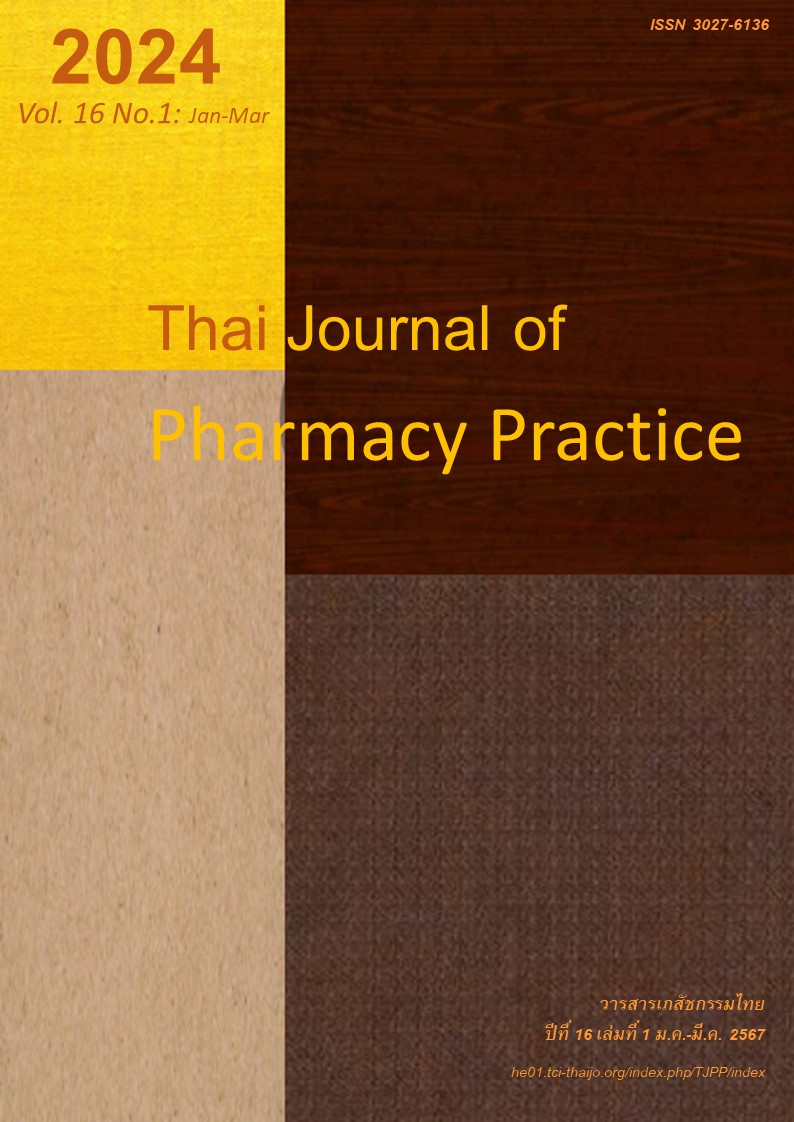การพัฒนาแบบวัดความร่วมมือในการใช้ยาสำหรับยารับประทาน: การทดสอบในผู้ป่วยโรคความดันโลหิตสูง
Main Article Content
บทคัดย่อ
วัตถุประสงค์: เพื่อทดสอบความเที่ยงและความตรงของแบบวัดความร่วมมือในการใช้ยาสำหรับยารับประทาน (Medication Adherence Measure for Oral Medicines หรือ MAM-O) ในผู้ป่วยโรคความดันโลหิตสูงและหาจุดตัดคะแนนที่แสดงถึงระดับความร่วมมือในการใช้ยาที่เหมาะสม วิธีการ: แบบวัด MAM-O ปรับปรุงจากแบบวัด MAST (Medication Adherence Scale for Thais) ที่มีคำถามจำนวน 8 ข้อและระดับคำตอบ 6 ตัวเลือก งานวิจัยนี้ลดจำนวนระดับคำตอบให้มี 4 ตัวเลือก แบบวัดผ่านการทดสอบความตรงเชิงเนื้อหาโดยผู้เชี่ยวชาญ 4 ท่าน และศึกษานำร่องในผู้ป่วยโรคความดันโลหิตสูงจำนวน 15 คน จากนั้นทดสอบแบบวัดในผู้ป่วยโรคความดันโลหิตสูงจำนวน 240 คน ผู้เข้าร่วมโครงการวิจัยทุกคนตอบแบบวัด MAM-O และ the EuroQoL 5-Dimension 5-Level (EQ-5D-5L) ผู้วิจัยนับเม็ดยาของผู้ป่วยที่เหลือในเดือนที่ 0, 3 และ 6 การศึกษาหาจุดตัดคะแนนของแบบวัดใช้ receiver operating characteristic curve (ROC curve) ผลการวิจัย: ค่าสัมประสิทธิ์ Cronbach's Alpha ของ MAM-O ที่วัดในเดือนที่ 0 และ 6 เท่ากับ 0.73 และ 0.75 ตามลำดับ ซึ่งเป็นค่าความเที่ยงที่ยอมรับได้ ค่าความเที่ยงจากการทดสอบซ้ำอยู่ในเกณฑ์ดี (r = 0.754) MAM-O มีความตรงตามเกณฑ์สัมพันธ์ โดยมีความสัมพันธ์กับการนับเม็ดยาที่เหลือในเวลาต่าง ๆ (r = 0.544-0.764; P<0.001) และมีความตรงเชิงโครงสร้างโดยมีความสัมพันธ์กับคุณภาพชีวิต (r = 0.531; P<0.001) และสามารถแยกกลุ่มที่ควบคุมระดับความดันโลหิตได้และไม่ได้ออกจากกันได้ (P<0.001) จุดตัดคะแนนของ MAM-O คือ 21 คะแนน (จากคะแนนเต็ม 24) และมีพื้นที่ใต้โค้ง ROC เท่ากับ 0.90 ค่าความไวและความจำเพาะเท่ากับ 92.5 และ 80.9 ตามลำดับ สรุป: แบบวัด MAM-O มีความเที่ยง ความตรง ความไว และความจำเพาะที่ดี ดังนั้นจึงสามารถนำแบบวัดนี้มาใช้เพื่อประเมินความร่วมมือในการใช้ยาในผู้ป่วยโรคความดันโลหิตสูงได้
Article Details

อนุญาตภายใต้เงื่อนไข Creative Commons Attribution-NonCommercial-NoDerivatives 4.0 International License.
ผลการวิจัยและความคิดเห็นที่ปรากฏในบทความถือเป็นความคิดเห็นและอยู่ในความรับผิดชอบของผู้นิพนธ์ มิใช่ความเห็นหรือความรับผิดชอบของกองบรรณาธิการ หรือคณะเภสัชศาสตร์ มหาวิทยาลัยสงขลานครินทร์ ทั้งนี้ไม่รวมความผิดพลาดอันเกิดจากการพิมพ์ บทความที่ได้รับการเผยแพร่โดยวารสารเภสัชกรรมไทยถือเป็นสิทธิ์ของวารสารฯ
เอกสารอ้างอิง
World Health Organization. Adherence to long-term therapies: evidence for action. [online]. 2003 [cited Apr 8, 2023]. Available from: apps.who.int
Khayyat SM, Mohamed MM, Khayyat SMS, Hyat- Alhazmi RS, Korani MF, Allugmani EB, et al. Association between medication adherence and quality of life of patients with diabetes and hypertension attending primary care clinics: a cross-sectional survey. Qual Life Res 2019; 28: 1053-61.
Neiman AB, Ruppar T, Ho M, Garber L, Weidle PJ, Hong Y, et al. CDC grand rounds: improving medication adherence for chronic disease manage ment—innovations and opportunities. MMWR Morb Mortal Wkly Rep 2017; 66: 1248.
World Health Organization. Guideline for the pharmacological treatment of hypertension in adults [online]. 2021 [cited Mar 20, 2023]. Available from: www.who.int/publications/i/item/9789240033986
Health Systems Research Institute. The 6th survey of Thai public health by physical examination 2019-2020 [online]. 2021 [cited May 9, 2022]. Available from: www.hsri.or.th/research/detail/13462.
Abegaz TM, Shehab A, Gebreyohannes EA, Bhagava thula AS, Elnour AA. Nonadherence to antihyperten- sive drugs: a systematic review and meta-analysis. Medicine (Baltimore) 2017; 96: e5641. doi:10.1097/ MD.0 00 0000000005641.
World Health Organization. Hypertension [online]. 2023 [cited Apr 3, 2023]. Available from: www.who. int/news-room/fact-sheets/detail/hypertension
Fortuna RJ, Nagel AK, Rocco TA, Legette-Sobers S, Quigley DD. Patient experience with care and its association with adherence to hypertension medica- tions. Am J Hypertens 2018; 31: 340-5.
Lam WY, Fresco P. Medication adherence measures: an overview. Biomed Res Int 2015; 2015: 217047. doi: 10.1155/2015/217047.
Stirratt MJ, Dunbar-Jacob J, Crane HM, Simoni JM, Czajkowski S, Hilliard ME, et al. Self-report measures of medication adherence behavior: recommendations on optimal use. Transl Behav Med 2015; 5: 470-82.
Morisky DE, Ang A, Krousel-Wood M, Ward HJ. Predictive validity of a medication adherence mea- sure in an outpatient setting. J Clin Hypertens 2008; 10: 348-54.
Sakthong P, Chabunthom R, Charoenvisuthiwongs R. Psychometric properties of the Thai version of the 8-item Morisky Medication Adherence Scale in patients with type 2 diabetes. Ann Pharmacother 2009; 43: 950-7
Svarstad BL, Chewning BA, Sleath BL, Claesson C. The brief medication questionnaire: a tool for screening patient adherence and barriers to adherence. Patient Educ Couns 1999; 37: 113-24.
Sriwarakorn S. Sensitivity and specificity of self-reported medication adherence tools [master thesis]. Bangkok: Chulalongkorn University; 2009.
Sakthong P, Sonsa-Ardjit N, Sukarnjanaset P, Munpan W, Suksanga P. Development and psychometric testing of the medication taking behavior tool in Thai patients. Int J Clin Pharm 2016; 38: 438-45.
Jongwilaikasem K, Lerkiatbundit S. Development of the Medication Adherence Scale for Thais (MAST). Thai Journal of Pharmacy Practice 2021; 13: 17-30.
Thai Hypertension Society. Guidelines in the treat- ment of hypertension [online]. 2019 [cited May 13, 2022]. Available from: www.thaihypertension.org/ guideline.html
Hinkin TR. A brief tutorial on the development of measures for use in survey questionnaires. Organ Res Methods 1998; 2: 104-12.
Karve S, Cleves MA, Helm M, Hudson TJ, West DS , Martin BC. Good and poor adherence: optimal cut-point for adherence measures using administrative claims data. Curr Med Res Opin 2009; 25: 2303-10.
Pattanaphesaj J. Health-related quality of life mea- sure (EQ-5D-5L): measurement property testing and its preference-based score in Thai population [dissertation]. Salaya: Mahidol University; 2014.
Al‐Jabi SW, Zyoud SeH, Sweileh WM, Wildali AH, Saleem HM, Aysa HA, et al. Relationship of treat- ment satisfaction to health‐related quality of life: findings from a cross‐sectional survey among hypertensive patients in Palestine. Health Expect 2015; 18: 3336-48.
Polit DF, Beck CT, Owen SV. Is the CVI an acceptable indicator of content validity? Appraisal and recommendations. Res Nurs Health 2007; 30: 459-67.
Alhaddad IA, Hamoui O, Hammoudeh A, Mallat S. Treatment adherence and quality of life in patients on antihypertensive medications in a Middle Eastern population: adherence. Vasc Health Risk Manag 2016; 12: 407-13.
Nunnally JC, Bernstein IH. Psychometric theory. 3rd ed. New York, USA: McGraw-Hill; 1994. p.83-103.
Kyngas HA, Skaar-Chandler CA, Duffy ME. The development of an instrument to measure the compliance of adolescents with a chronic disease. J Adv Nurs 2000; 32: 1499-506.
Souza AC, Borges JWP, Moreira TMM. Quality of life and treatment adherence in hypertensive patients: systematic review with meta-analysis. Rev Saude Publica 2016; 50: 71. doi: 10.1590/S1518-87 87.2016050006415.
Svarstad BL, Chewning BA, Sleath BL, Claesson C. The Brief Medication Questionnaire: a tool for screening patient adherence and barriers to adhe- rence. Patient Educ Couns 1999; 37: 113-24.
Riffenburgh RH. Statistics in medicine. 3rd ed. United States: Academic Press; 2012.
Kim MT, Hill MN, Bone LR, Levine DM. Develop- ment and testing of the Hill-Bone Compliance to High Blood Pressure Therapy Scale. Prog Cardiovasc Nurs 2000; 15: 90-6.
Nemoto T, Beglar D. Developing Likert-scale ques- tionnaires. [online]. 2014 [cited Apr 8, 2023]. Available from: jalt-publications.org/files/pdf-article/ jalt2013_001.pdf.
Baumgartner H, Steenkamp J-BE. Response styles in marketing research: a cross-national investiga- tion. J Mark Res 2001; 38: 143-56.


